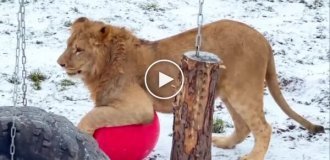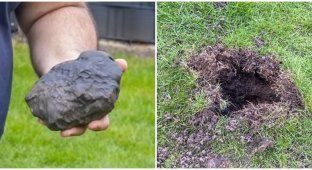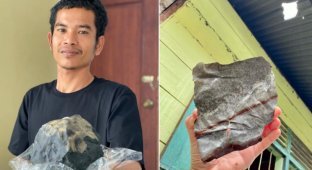Goba is the largest meteorite on Earth (4 photos)
It’s worth making a reservation right away: the largest of those found, and not known to science. But then there was the famous Tunguska meteorite, the diameter of which (according to the NASA modeled fall model) was approximately 70–80 meters. But not a trace remains of it, and scientists are still wondering whether there was a meteorite and whether it fell at all? 
Goba meteorite in Namibia
Unlike the block known as Goba. This is already quite real evidence of a cosmic advent. It is located in Namibia and is a local landmark. Of course, a metal piece weighing 60 tons flaunts its rusty sides in the center of an amphitheater specially built for it.
Farmer Brits's Find
In fact, the weight of Goba was determined solely by calculation, when the meteorite became widely known to the scientific world. And then for over 60 years he slowly “lost weight”, losing his parts to the sound of hammers and chiseling numerous tourists. It was only in 1987 that the meteorite was taken under protection, the area around it was improved and video surveillance was installed.
The space guest arrived on Earth 80,000 years ago, and what’s interesting is that he didn’t leave any crater behind. No, there was a hole, but most likely with a diameter of 20 meters and a depth of about five (according to modern computer flight modulation). Over such a long time, it became level with the surface, and the meteorite itself was completely covered with a layer of earth. He would never have been found if not for the Dutch farmer Jacobus Brits. He lived on a farm called Goba West and owned a large plot of land.
In 1918, while plowing virgin soil, he came across a stone. I tried to uproot it, but when I realized that the block was much larger than it seemed, I gave up. The following year, Brits made a second attempt. He dug up the ground around the stone and measured its dimensions - three by three meters. The farmer found out the third parameter—the depth of occurrence—a year later. As a result, in front of him lay a 3*3*1 meter stone consisting of a strange substance. Brits was convinced that these were not ordinary earthly rocks by the scratches - they left a characteristic “metallic” trace. And in general, the stone began to become covered with rust over time, like a piece of old scrap. 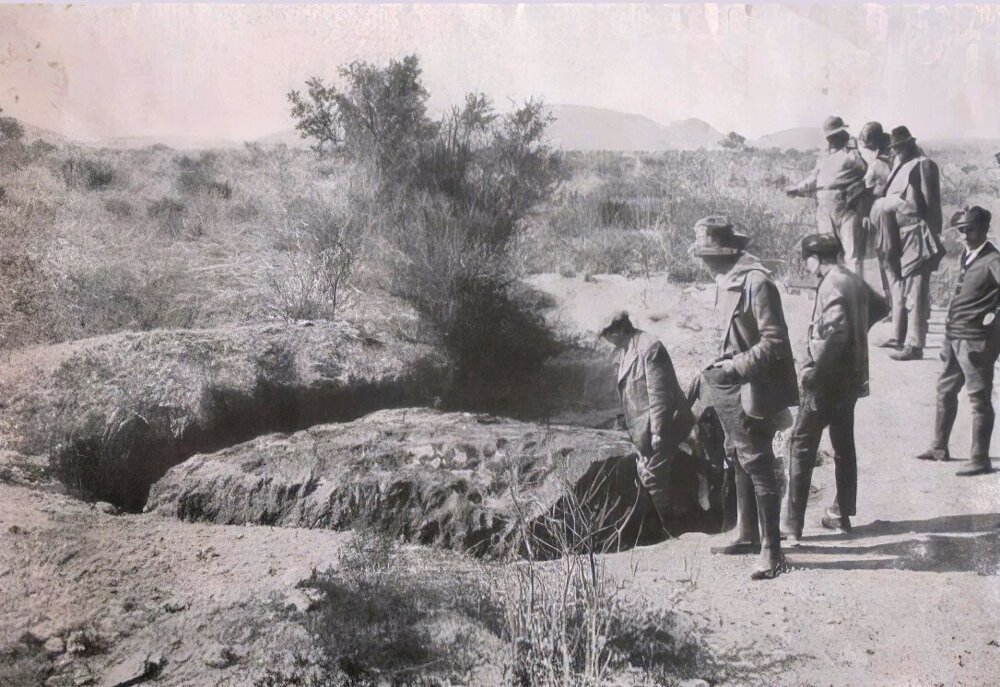
Goba meteorite in 1928/
How much does it cost?
The farmer chipped off a tiny particle with a chisel and sent it for examination to the South West African Company, from where the answer soon came that it was most likely a meteorite substance. It was then that its composition was determined - 81% iron and 17% nickel. The news made Brits very happy. Little was known about meteorites at that time, so the farmer figured that science would pay a huge sum for him. But who should you sell it to, and most importantly, for how much?
The farmer decided to find out the answer to the second question at the Transvaal Museum. He wrote them a letter: “Could you tell me what size meteorites are usually found in Africa and how much the find is worth?” Soon the answer came. In it, the specialist described in detail to Brits about all cases of meteorite discovery known to science. And when asked about the price he said sparingly:
Meteorites are not sheep or cows, and I cannot give a fixed price. Perhaps it is determined by the amount that museums are willing to pay, and, among other things, by the possibilities of its transportation.
Oh, yes, transportation... Brits completely missed this issue. He tried to move the meteorite, which had been completely excavated by that time, but neither a couple of horses nor four of them could do it. But besides moving, the valuable acquisition had to be somehow pulled out of the hole. Then the farmer tried to split it into pieces, but it was not possible to do it with improvised means.
Geologists who arrived at the site thanks to his letter called on Brits to stop his useless undertakings. At the same time, the approximate weight of the “space guest” was calculated - 65 tons. It was impossible to move such a mass from its place by any means of mechanization. Therefore, for some time we had to forget about selling the meteorite. 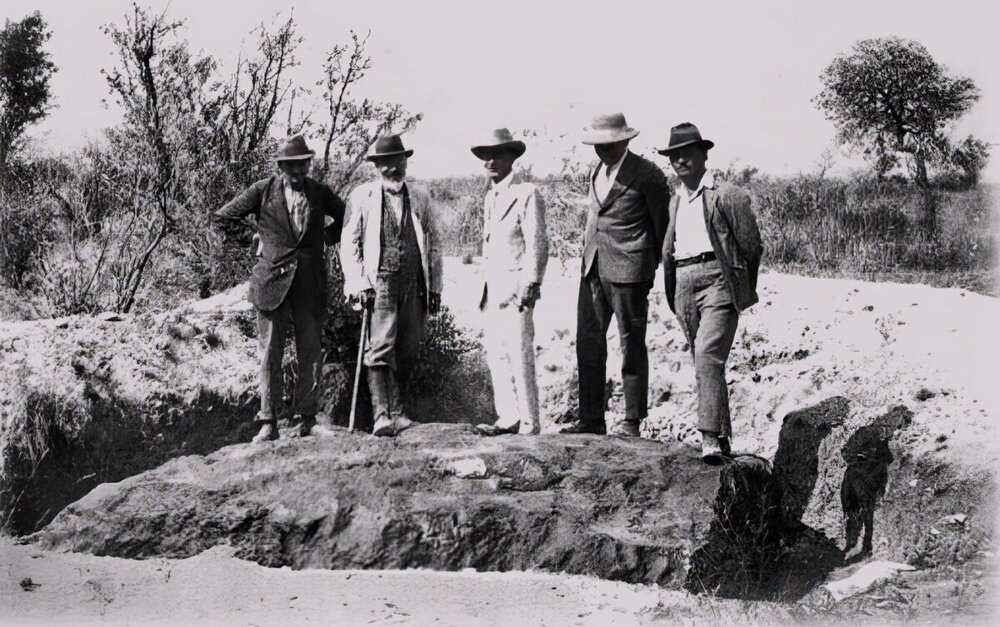
Participants of the International Geological Congress at the Goba meteorite/
A piece of iron under guard
Meanwhile, his fame began to spread and go beyond Africa. In 1923, Goba (the meteorite was named after the area where it was discovered) was included in the “Catalog of Meteorites”, and in 1929 it was visited by participants of the International Geological Congress. Gradually, news of the discovery of the world's largest meteorite reached Europe.and America. Dozens of tourists flocked to visit Jacobus Brits. Each of them tried to break off a piece as a souvenir. Thus, Goba began to gradually lose weight. Well, chemical erosion (80% iron) helped in this matter. As a result, by the 50s, the meteorite began to weigh 63 tons.
By that time, at the insistent requests of the authorities of the Union of South Africa, Brits' descendants sold the site to the state, and it awarded the meteorite the status of a national monument. However, this did not change the situation at all - Goba continued to be robbed. Only in 1987 did the Namibian authorities take the meteorite under protection, develop a tourist area around it and categorically prohibit acts of vandalism. 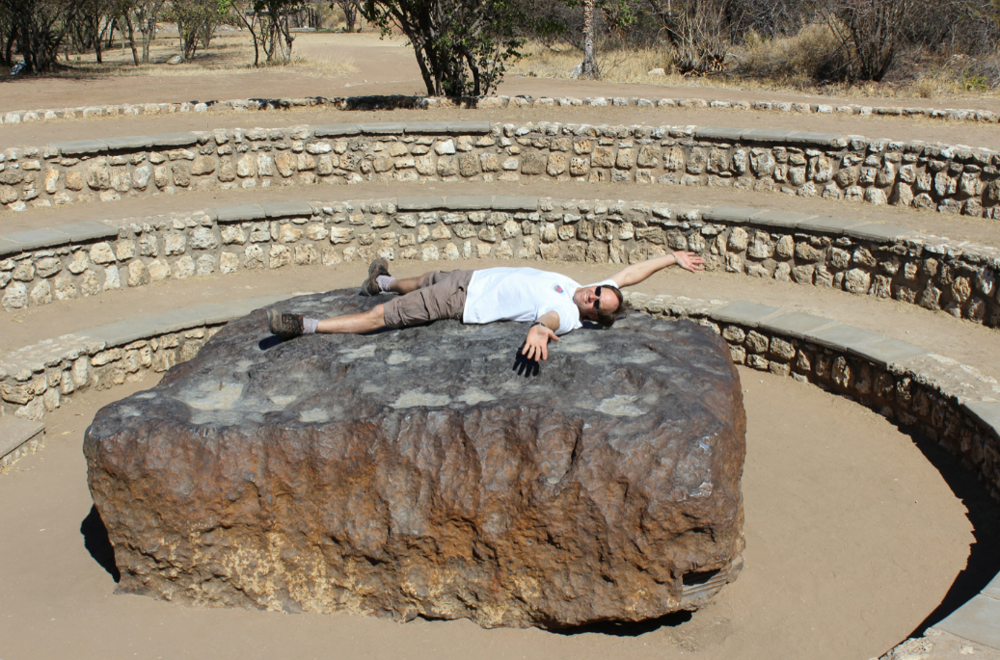
You can take pictures riding on a meteorite, but you can’t rob it
As for the scientific side of the issue, Goba belongs to class IV B iron meteorites (ataxites). And the absence of a crater during its fall is explained by the low angle of flight - the modeling showed that Goba most likely fell at an angle of 5° to the Earth’s surface, as if gliding along it. However, there are alternative hypotheses, for example, this one. 80,000 years ago, a large glacier was located on the site of Namibia. The meteorite left a powerful crater on its surface, but much later, when the ice began to melt, Goba simply smoothly sank to the ground.
To date, it is considered the largest meteorite found on the planet. But not only. Goba is also the largest piece of iron of natural origin.
Despite the security and cameras, tourists manage to scratch their names on it (however, they quickly disappear under a layer of rust), but no one else undertakes to break off pieces - this is a long and, most importantly, noisy task. At the piercing high-pitched metallic ringing, all the security guards of the tourist center immediately come running.

